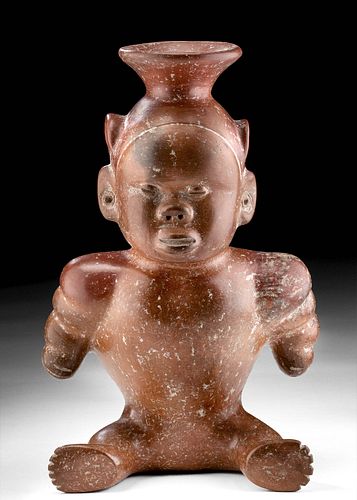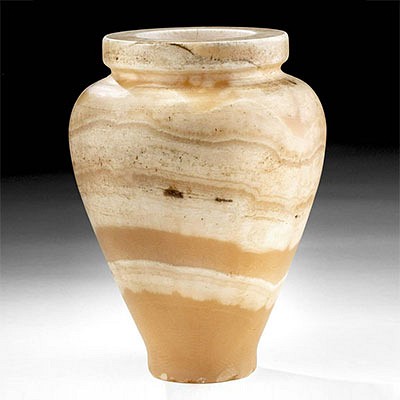Colima Redware Dwarf Vessel - ex Sotheby's
Lot 121
About Seller
Artemis Gallery
686 S Taylor Ave, Ste 106
Louisville, CO 80027
United States
Selling antiquities, ancient and ethnographic art online since 1993, Artemis Gallery specializes in Classical Antiquities (Egyptian, Greek, Roman, Near Eastern), Asian, Pre-Columbian, African / Tribal / Oceanographic art. Our extensive inventory includes pottery, stone, metal, wood, glass and textil...Read more
Categories
Estimate:
$4,000 - $6,000
Absentee vs Live bid
Two ways to bid:
- Leave a max absentee bid and the platform will bid on your behalf up to your maximum bid during the live auction.
- Bid live during the auction and your bids will be submitted real-time to the auctioneer.
Bid Increments
| Price | Bid Increment |
|---|---|
| $0 | $25 |
| $300 | $50 |
| $1,000 | $100 |
| $2,000 | $250 |
| $5,000 | $500 |
| $10,000 | $1,000 |
| $20,000 | $2,500 |
| $50,000 | $5,000 |
| $100,000 | $10,000 |
| $200,000 | $20,000 |
About Auction
By Artemis Gallery
Dec 17, 2020
Set Reminder
2020-12-17 10:00:00
2020-12-17 10:00:00
America/New_York
Bidsquare
Bidsquare : VARIETY SALE | Antiquities & Ethnographic Art
https://www.bidsquare.com/auctions/artemis-gallery/variety-sale-antiquities-ethnographic-art-6207
Featuring classical antiquities, ancient and ethnographic art from cultures encompassing the globe. Egyptian, Greek, Roman, Etruscan, Near Eastern, Asian, Pre-Columbian, Native American, African / Tribal, Oceanic, Spanish Colonial, Russian, Fossils, Fine Art, more! Artemis Gallery info@artemisgallery.com
Featuring classical antiquities, ancient and ethnographic art from cultures encompassing the globe. Egyptian, Greek, Roman, Etruscan, Near Eastern, Asian, Pre-Columbian, Native American, African / Tribal, Oceanic, Spanish Colonial, Russian, Fossils, Fine Art, more! Artemis Gallery info@artemisgallery.com
- Lot Description
Pre-Columbian, West Mexico, Colima, Protoclassic Period, ca. 100 BCE to 250 CE. A fascinating redware dwarf effigy vessel, the seated figure presenting with out-turned legs, relatively large feet with delineated toes, broad torso and shoulders, and rippling muscular attenuated arms that terminate in a point. The figure's visage is comprised of coffee bean shaped eyes, an upturned nose with delineated nostrils, full somewhat parted lips, pierced ears, a caplike coiffure or headdress adorned with crescentic head ornaments, with the vessel's flaring spout emerging from the top. The highly-burnished hunchbacked figure suffers from a severe case of dwarfism made evident by his dramatic forward-leaning posture and his malformed spine which almost protrudes through his back. Scholars posit that in the Pre-Columbian world, such physical deformities were interpreted as signs from the divine, indicating that these individuals were touched by the supernatural. Size: 7.375" W x 11.7" H (18.7 cm x 29.7 cm)
Interestingly, Colima sculptors portrayed many hunchback and dwarf individuals, and some have theorized that this relates to their relatively high social status. In addition, some scholars attribute the hunched back in West Mexican shaft tomb culture to a particular form of tuberculosis.
Colima, located on Mexico's southwestern coast, was during this time part of the shaft tomb culture, along with neighbors to the north in Jalisco and Nayarit. In this culture, the dead were buried down shafts - 3 to 20 meters deep - that were dug vertically or near vertically through the volcanic tuff that makes up the geology of the region. The base of the shaft would open into one or more horizontal chambers with a low ceiling. These shafts were almost always dug beneath a dwelling, probably a family home, and seem to have been used as family mausoleums, housing the remains of many related individuals. This is a figure made to be placed inside those mausoleums, perhaps to mediate between the worlds of the living and the dead.
For a similar example of a Colima seated hunchback figure, please see The Metropolitan Museum of Art, accession number X.2.431
Provenance: ex private Richmond, Connecticut, USA collection; ex Sotheby's New York - 14 May 1991, Lot 152
All items legal to buy/sell under U.S. Statute covering cultural patrimony Code 2600, CHAPTER 14, and are guaranteed to be as described or your money back.
A Certificate of Authenticity will accompany all winning bids.
We ship worldwide and handle all shipping in-house for your convenience.
#159787Both legs reattached to lower body with nearly invisible resurfacing and overpainting along break lines. Minor abrasions to limbs, body, and head, with light encrustations, and some root marks. Great remains of original pigment throughout. Old inventory label beneath base.Condition
- Shipping Info
-
All shipping is handled in-house for your convenience. Your invoice from Artemis Gallery will include shipping calculation instructions. If in doubt, please inquire BEFORE bidding for estimated shipping costs for individual items.
-
- Buyer's Premium



 EUR
EUR CAD
CAD AUD
AUD GBP
GBP MXN
MXN HKD
HKD CNY
CNY MYR
MYR SEK
SEK SGD
SGD CHF
CHF THB
THB
















